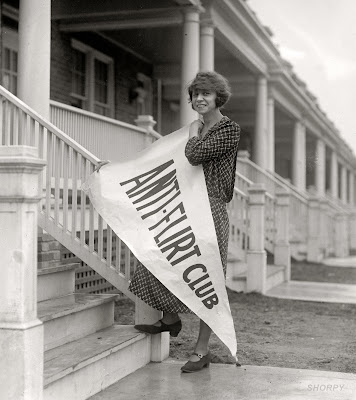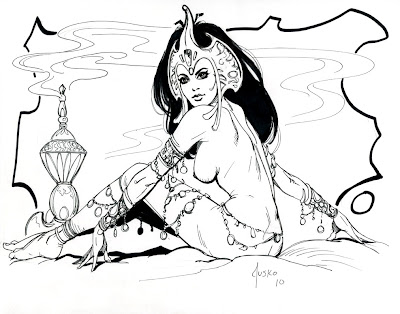Showcase Presents: The Secrets of Sinister House
(DC Comics, 2010)
Writers: Michael Fleisher, Joe Albano, E. Nelson Bridwell, Sheldon Mayer, Jack Olek, Robert Kanigher, George Kashdan, et.al.
Artists: Tony DeZuniga, Alfredo Alcala, Dick Giordano, Don Heck, Mike Sekowsky, Rico Rival, Alex Nino, et.al.
Rating: Six of Ten Stars
In the early 1970s, DC Comics made numerous attempts to expand their market beyond the superhero titles that have always been the bread-and-butter of the American comic book industry; they'd already been enjoying tremendous success with war titles, so it was reasonable to take a crack at fantasy, horror, sci-fi... and romance.
First published in September of 1971, "The Sinister House of Secret Love" was one of the less successful experiments, be it on a commercial or artistic level. The series began as a vehicle for "book-length" tales of gothic romance that, despite the fact the covers implied a degree of horror content, were so close-hewn to genre standards that one could use them as teaching aids in a class on the subject.
However, it must have quickly been obvious to the editors and business folks at DC Comics that their foray into the gothic romance market was not setting the publishing world on fire. The first four issues have covers with an unadulterated paperback romance novel cover vibe (complete with the standard
"women running from houses" motif), but starting with the fourth issue they started making obvious attempts to play up the horror aspect of the gothic romance genre, first redesigning the cover logo so "The Sinister House" was really large and "of Secret Love" was very tiny and describing the story within the covers as a "graphic tale of gothic horror" even though it actually contained fewer overt horror elements than tale in issue #2; and retitling the series "Secrets of the Sinister House" as of issue #5.
But it wasn't enough, so by issue #6 the book-length gothic romance stories were gone and the title morphed into an anthology book, joining the long-running "House of Mystery" and "House of Secrets" horror/thriller anthology titles in DC's line-up. Several of the stories presented still had more of a romance flavor than most of the tales presented in DC Comics' horror anthologies--possibly because some had been commissioned as back-up stories like the one featured in the first issue of the series. However, "Secrets of the Sinister House" didn't catch on the way the other titles had, and by issue #18, it was cancelled.
Thanks to DC Comics' low-cost black-and-white series of "Showcase Presents" reprint books, all the tales presented in this failed experiment can now be enjoyed by modern audiences. It's a book that might appeal for a number of different reasons, although given the shift in direction halfway through, not everything is going to be of interest to everybody.
Fans of the gothic romance genre in particular might want to give the book a read as "The Curse of the MacIntyres" (from issue #1), "To Wed the Devil" (from issue #2) and "The Bride of the Falcon" (from issue #3) and "Death at Castle Dunbar" (from issue #5) are rather decent efforts, both story and artwise.
The second half of the book is of interest to fans of short-format horror comics, as it contains a couple dozen tales of marauding monsters, vicious villains, and poetic justice. As was the case with all of DC Comics' anthology titles, the entertainment value of these short stories varies greatly but the artwork is universally top-notch.
In fact, the only group this entire book will appeal to are lovers of comic books as an art-form as well as an entertainment medium. For the first half of the book, we get to see great artists like Don Heck, Tony DeZuniga, Dick Giordano, and Alex Toth at their finest, and in the case of Heck working in a rare non-superhero environment. The short horror stories with art by Alfredo Alcala, Rico Rival, and other artists from the Philippines are visually gorgeous--even more so in the black-and-white reprint format than in their original presentation--no matter how wretched some of the stories. In fact, with the exception of the art by Tony DeZuniga, just about every story in this book looks better than it did back when it was first presented 40 years ago... and the only reason DeZuniga's work suffers is because a number of panels and layouts were clearly designed with coloring in mind. As a result some seem a bit vacant and sparse in appearance.
"Secrets of the Sinister House" may be an uneven collection, but it's the sort of offbeat material that I hope to see more of in the "Showcase Presents" series. I'd REALLY love a book collecting the myriad of characters that came and went with barely a ripple, such as Nightmaster, Kong the Untamed, Firehair, and Black Orchid. I hope this volume of obscure non-superhero comics sells well enough to encourage DC Comics to bring us more of the same.
Trivia: In reading this book, I realized that "The Secrets of Sinister House" #8 was one of the first comics I ever read. "Paying with Fire" (the story of a boy, awful parents, and a dragon) and "Moonlight Bay" (the tale of a werewolf astronaut) stayed with me in my imagination to this very day. It was great to be reminded of where they came from originally.





























































.jpg)






.jpg)
